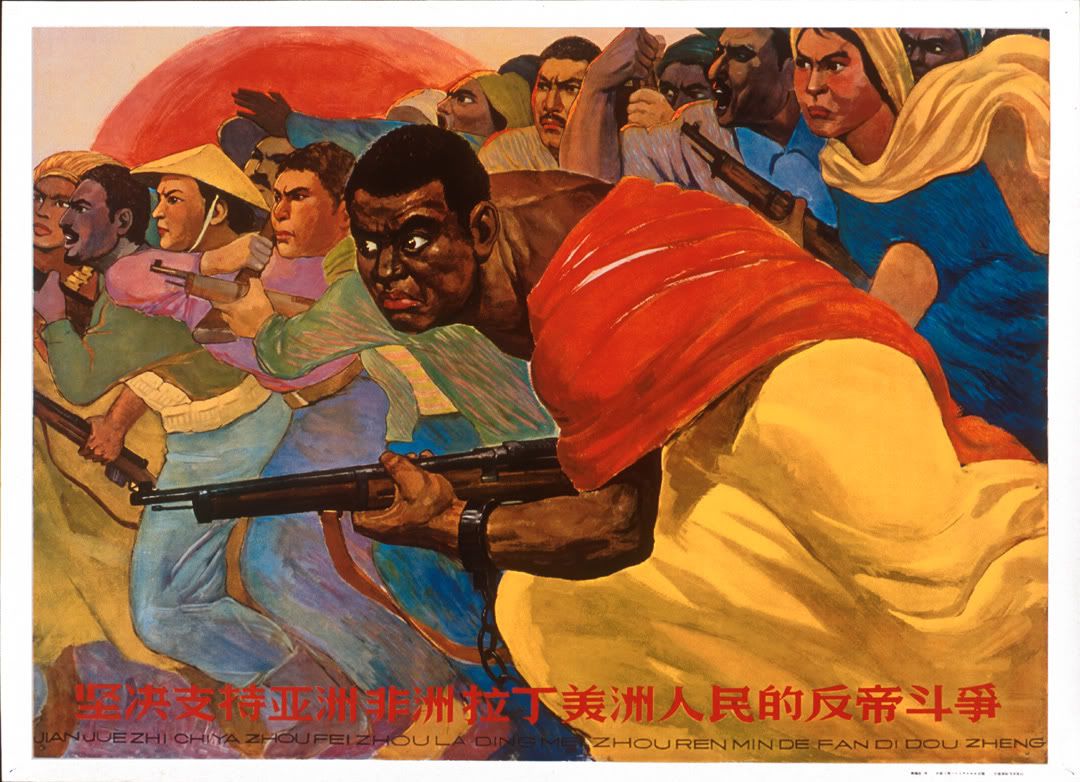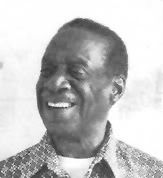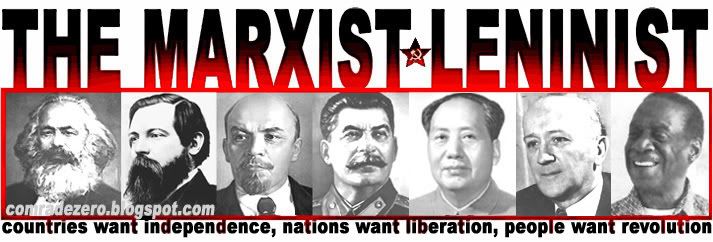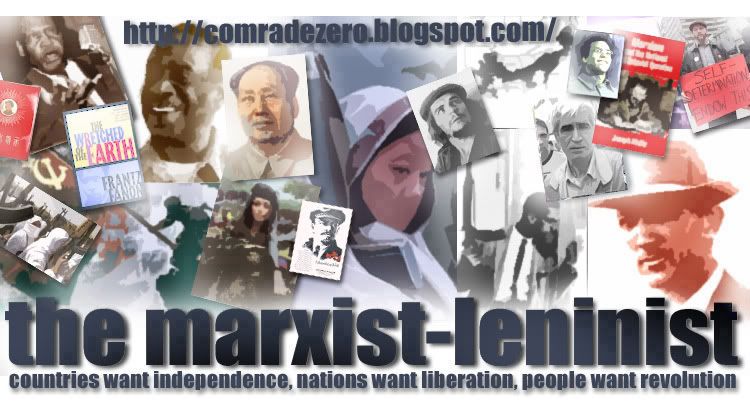 When the Sino-Soviet split began folowing Khrushchev's denunciation of Comrade Stalin, the founder of the modern antirevisionist movement, Comrade Mao Zedong, wrote, first in Ten Major Relationships (1956), that "it is the opinion of the Central Committee that Stalin's mistakes amounted to only 30 per cent of the whole and his achivements to 70 per cent, and that all things considered Stalin was a great Marxist."
When the Sino-Soviet split began folowing Khrushchev's denunciation of Comrade Stalin, the founder of the modern antirevisionist movement, Comrade Mao Zedong, wrote, first in Ten Major Relationships (1956), that "it is the opinion of the Central Committee that Stalin's mistakes amounted to only 30 per cent of the whole and his achivements to 70 per cent, and that all things considered Stalin was a great Marxist."
This simple ratio, 70-30, has done a great deal towards the evaluation of Stalin and has framed a substantial portion of the debate within the antirevisionist movement. Though I would argue that it is not so simple.
Only a year later, in Be Activists in Promoting the Revolution (1957), Mao wrote,
We have put Stalin's portrait up in Tien An Men Square. This accords with the wishes of the working people the world over and indicates our fundamental differences with Khrushchev. As for Stalin himself, you should at least give him a 70-30 evaluation, 70 for his achievments and 30 for his mistakes. This may not be entirely accurate, for his mistakes may be only 20 or even 10, or perhaps somewhat more than 30. All things considered, Stalin's achievments are primary and his shortcomings and mistakes are secondary. On this we take a view different from Khrushchev's.
It is strange that the question of Stalin is so unclear! In the interest of clarity it is therefore necessary to establish, bit by bit, which of Stalin's contributions must be chalked up as positive and which as negative. Thanks to a comment from Celtic Fire regarding how he "upholds Stalin" ("Stalin's definition of nationalities was wrong. Stalin's understanding of contradictions among the people was mechanical. And Stalin's understanding of socialist development was wrong"), we have a nice set of issues wherein to ground this question. So we shall go through each of these "errors" of Stalin, in the interest of "summing up the success and failures, and understanding how to advance," as Celtic Fire says.
First then, we shall look at Stalin's "definition of nationalities" and the application of the Marxist-Leninist national question in the Soviet Union. I intend to show here that we should chalk this one up on the "achievements" side of the 70-30 (or 80-20, or 90-10), and that, in summing it up and applying it to our conditions in the U.S., we can see how to advance.
Josef Stalin and the National Question in the Soviet Union
 In 1912, Josef Stalin developed the Marxist-Leninist definition of a nation: "A nation is a historically constituted, stable community of people, formed on the basis of a common language, territory, economic life, and psychological make-up manifested in a common culture" (Stalin, Marxism and the National Question). This definition became the standard used in Marxist-Leninist analysis until the 50s when revisionism took over in the USSR and elsewhere. It influenced Communists the world over, including Lenin, who, in 1913 wrote that Stalin's work on the national question should be given "prime place" in theoretical Marxist literature (Lenin, The National Program of the R.S.D.L.P.).
In 1912, Josef Stalin developed the Marxist-Leninist definition of a nation: "A nation is a historically constituted, stable community of people, formed on the basis of a common language, territory, economic life, and psychological make-up manifested in a common culture" (Stalin, Marxism and the National Question). This definition became the standard used in Marxist-Leninist analysis until the 50s when revisionism took over in the USSR and elsewhere. It influenced Communists the world over, including Lenin, who, in 1913 wrote that Stalin's work on the national question should be given "prime place" in theoretical Marxist literature (Lenin, The National Program of the R.S.D.L.P.).
We must remember that Russia, under the Tzar, was called the "prisonhouse of nations." The Lenin-Stalin line was that oppressed nations had the right to secession, that is, to seperate statehood. Just as Lenin, in the split with the Second International (the social-democrats of the Second International argued that the imperialist war taking place was benefitting the workers in the imperialist countries and should not be opposed), would make a central issue out of opposing "ones own" imperialist government, (see Lenin, Socialism and War), so to would he make an issue of dealing with imperialism within "one's own" country. Lenin addresses this at length in Right of Nations to Self-Determination (1914). He goes to great lengths to show that nations have a right to self-determination, that in the end, that means a right to political power, and even a right to seceed. Union is like a marriage. It is voluntary. Secession is a right, like divorce. Lenin also goes to great lengths to show that this does not mean a right to form bourgeois seperatist movements that will harm the international working class:
By supporting the right to secession, we are told, you are supporting the bourgeois nationalism of the oppressed nations ... Our reply to this is: No, it is to the bourgeoisie that a "practical" solution to this question is important. To the workers the important thing is to distinguish the principles of the two trends. Insofar as the bourgeoisie of the oppressed nation fights the oppressor, we are always, in every case, and more strongly than anyone else, in favor, for we are the staunchest and most consistent enemies of oppression. But insofar as the bourgeoisie of the oppressed nation stands for its own bourgeois nationalism, we stand against. We fight against the privileges and violence of the oppressor nation, and do not in any way condone striving for privilages on the part of the oppressed nation.
This is clear enough.
The most common criticism of Stalin's handling of oppressed nationalities first entered mass consciousness with the much publicized Islamic seperatist rebellion in Chechnya which began in 1991 with the declartion of Chechen independence from Russia. This matured into a civil war when Yeltsin sent in troops in 1994 to restore Russian authority. The Russian's were defeated and Aslan Maskhadov was elected and recognized by Russia as the presedent of Chechnya. In 1999 Chechens crossed into Dagestan to start another armed Islamic uprising and the war began anew with the Chechen mujahidin intending to set up an Islamic state based on Sharia law.
This violence is blamed, like most other problems in the former Soviet Union, on Stalin.
Stalin, as everybody knows, deported the Chechens en mass in 1944 hundreds of miles to the east of their homeland. Stalin's view was basically that, in general, the Chechens seperatist tendencies would serve the Nazis and that basically Hitler's armies would be able to recruit them into service agianst the USSR merely by handing out guns. Now, picking up something the size of Chicago and moving it over to New York in the middle of the largest and most brutal war in human history with very few available resources (such as transportation, trains, etc) would be no easy feat. This is roughly what Stalin achieved. Was it a difficult trip? Yes, of course it was. Was it necessary? Yes, I think it was. The leaders told the Nazis that they would support them if the Nazis would back Chechen independence (bourgeois seperatism; see also "Ethnic Crisis in the Caucuses). Stalin destroyed this nationalist revolt just behind the Caucasian line by picking up these people and moving them away from the front. They were not allowed to return until after Stalin's death, when they found other nationalities on the land they had so long considered theirs.
As Stalin himself says in Foundations of Leninism (1924):
[The right of nations to self-determination] does not mean that the proletariat must support every national movement, everywhere and always, in every individual case. It means that support must be given to such national movements as tend to weaken, to overthrow imperialism, and not to strengthen and perserve it. Cases occur when the national movements in certain oppressed countries come into conflict with the interests of the development of the proletarian movement. In such cases support is, of course, entirely out of the question. The question of the rights of nations is not an isolated, self-sufficient question; it is a part of the general problem of proletarian revolution, subordinate to the whole, and must be considered from the point of view of the whole.
Stalin's critics want to blame him for the problem but I just don't see the evidence for such a blanket claim. I don't see that the Stalin government had any other choice but to quell the Chechen seperatist rebellion and save the Soviet Union. This is Leninism.
Even so, there is reason to believe that the Chechen mujahidin might see things slightly differently than your average anticommunist. Let us just consider this quote from Celtic Fire's interview with Grover Furr:
The older Chechen fighters like Mr. Basayev occasionally refer to a common Soviet past when communicating with Russians. Maksim Shevchenko, a Russian journalist who interviewed him frequently during the first war, recalled one such appeal by Mr. Basayev, who wears the long beard of Islamic radicals."He switched off the tape recorder and he said, `You think I was always this bearded fighter with a machine gun?' " recalled Mr. Shevchenko, who at the time was writing for the daily Nezavisimaya Gazeta. " `I also sang the song, "My address is not a home or street; my address is the Soviet Union." Those were very good times.' " (“With Few Bonds to Russia, Young Chechens Join Militants.” NYT November 19, 2002.)
One of the points Furr makes that I agree with in that interview (I agree with his positive assesment of Stalin on the national question in general) is that "Great-Russian chauvinism got progressively worse after Stalin died. But it never got to the point it is now."
Harry Haywood and the National Question in the United States
The South controls the nation and Wall Street controls the South - W.E.B. DuBois
 Of course the Lenin-Stalin line on the National Question was not only applied in the Soviet Union, but in other Comintern countries as well. Comrade Harry Haywood was a leading African American Communist who was in the Soviet Union from 1925 to 1930. There he travelled extensively and his observations of national relations in the former "prisonhouse of nations" are very positive, particularly in the Caucuses (see Haywood's critical and self-critical autobiography, Black Bolshevik: Autobiography of an Afro-American Communist). With the Comintern he worked to seek out solutions for the national question in the United States and South Africa.
Of course the Lenin-Stalin line on the National Question was not only applied in the Soviet Union, but in other Comintern countries as well. Comrade Harry Haywood was a leading African American Communist who was in the Soviet Union from 1925 to 1930. There he travelled extensively and his observations of national relations in the former "prisonhouse of nations" are very positive, particularly in the Caucuses (see Haywood's critical and self-critical autobiography, Black Bolshevik: Autobiography of an Afro-American Communist). With the Comintern he worked to seek out solutions for the national question in the United States and South Africa.
It took intervention from Comrade Stalin and the Comintern to put an end to the factionalism that was on the verge of tearing apart the young CPUSA. Additionally, Stalin and the Comintern had to intervene in the CPUSA's line on the national question, which had long suffered from white chauvanism. As the pioneering theorist of the national question in the United States, Haywood's theoretical contributions are tremendous. Apart from the two Comintern Resolutions on the African American National Question (1928 and 1930) which Haywood helped to draft, his major contributions to the Lenin-Stalin line on the national question were in his book Negro Liberation (1948) and the pamphlet For a Revolutionary Position on the Negro Question (1957), where he analyzes conditions in the U.S. and developed the theory that African American people made up an oppressed nation with territory in the Black Belt South. He argued, basically, that the Hayes-Tilden comprimise of 1877 had left unfinished the agrarian bourgeois democratic revolution of Reconstruction, leaving African Americans frozen as landless semi-slaves in the South, forged into nationhood by the uneven development which accompanies the rise of monopoly capitalism. African Americans found themselves shifted abruptly from revolution to Jim Crow and Klan terror. (Please see also, Lenin, Capitalism and Agriculture in the United States of America, particularly the section on "the former slave-owning south".)
This being the case, the only way to develop the revolution would be for the CPUSA to demand self-determination in the South and full equality throughout the rest of the country. Without this demand the CP could not dream of giving leadership to the national liberation movement and establishing genuine multinational working class unity. As Karl Marx himself put it, "Labor cannot emancipate itself in the white skin where in the black it is branded" (Capital).
It was this revolutionary line that gave rise to the struggle of the Sharecroppers Union in the 1930s. The battles of the Sharecroppers Union are some of the greatest moments of labor history. When the Great Depression hit, many small landowning farmers became tenant farmers and many tenant farmers were further disenfranchized. This left sharecropping, where tenants are provided with tools, land, and basic subsistance goods in exchange for a substantial portion of the value produced, basically a form of serfdom, as the dominant property relations in the rural South. The struggle to fight back advanced rapidly under the leadership of the party with the call for self-determination and agrarian revolution. The union grew to over 3,000 very militant members in a couple of years, at some points even involving armed struggle (see Robin D. G. Kelley, Hammer and Hoe: Alabama Communists During the Great Depression. Chapel Hill: University of North Carolina Press, 1990 for a thorough discussion of the sharecroppers struggle. It is also covered to lesser extent in Haywood's autobiography, as he was a participant).
The Freedom Road Socialist Organization document, The Third International and the struggle for a correct line on the African American National Question, sums all of this up rather well: "The net result was a developed base among all progressive classes in the Black community. The position of the multi-national working class was strengthened in the process, as was the communist movement." Of course, the document continues, revisionism damaged this severely:
While Marxist-Leninists inside the Communist Party waged a serious fight to oppose revisionism on a host of questions - including a defense of a revolutionary line on the African American National Question - in the end it proved necessary to break with revisionism and to create new communist organizations. In the 1960s many of these anti-revisionists, including Harry Haywood and others who grasped the importance of the African American national movement, were able to propagate an advanced line to a new generation of communists.
The Civil Rights Movement then was forced to grow up in a world where the CP, the party of the proletariat, had abandoned its revolutionary line on the national question. This left the party to tail behind the NAACP and Martin Luther King. Therefore we saw the development of the bourgeois democratic revolution fall under the leadership of rightists, and we saw the institutionalization of bourgeois right in the South with the passage of the Civil Rights Act and Voting Rights Act. We saw where this led - to Watts and countless other uprisings accross the country and to the militant "Black Power" national liberation movement. For working class African Americans, little had changed. And, unfortunately, the New Communist Movement lacked the experience or unity to take an effective leading role.
Not that important reforms weren't won in the Civil Rights Movement. Some important and necessary gains were made. But we didn't win all that could be won, that's certian. Malcolm X put it so simply. After discussing revolution in the U.S., France, the Soviet Union, China, and Algeria, and discussing their common characteristics (namely land and bloodshed) he talks about the "Negro revolution", that is, the nonviolent Civil Rights Movement:
The only kind of revolution that is nonviolent is the Negro revolution. The only revolution in which the goal is loving your enemy is the Negro reovlution. It's the only revolution in which the goal is a desegregated lunch counter, a desegregated theater, a desegregated park, and a desegregated public toilet; you can sit next to white folks - on the tiolet. That's no revolution. Revolution is based on land. Land is the basis of all independence. Land is the basis of freedom, justice, and equality ("Message to the Grassroots").
The National Question for Marxist-Leninists in the U.S. Today
The evil system of colonialism and imperialism grew up along with the enslavement of Negroes and the trade in Negroes, and it will surely come to its end with the thorough emancipation of the black people. - Mao Zedong, "Statement calling on the People of the World to Unite to Oppose Racial Discrimination by U.S. Imperialism and Support the American Negroes in the Struggle Against Racial Discrimination"
There is nothing more important, more necessary for the revolution here in the United States, than the building of a strategic alliance between the multinational working class and the national liberation movements under the leadership of the genuine vanguard party of the proletariat. Only such a new Communist Party can play a leading role in the mass movements of all working and oppressed people.
Despite some outmigrations and industrialization, the African American Black Belt has persisted, along with the need for national liberation and socialist revolution. We see national oppression in the Black Belt and in the Chicano nation in the Southwest (Aztlan). Still we see the lag of uneven development in the South destroying the revolutionary possibilities of the working class all over the country, and as long as this domestic imperialism persists, there will never be revolution in the United States.
Haywood, struggling against the revisionism in the party, wrote "On the Negro Question" in 1959. This was his final intervention in the line of the CPUSA before joining with the nascent Maoist movement where he continued to fight for the revolutionary line on the national question. In "On the Negro Question" he states very clearly,
It cannot be stressed enough that the changes which have taken place in the Black Belt have sharpened immeasurably the contradiction involved in the Negro Question, and do not blunt them as the proponents of the draft resolution assert in their efforts to create a rationale for desertion of our internationalist obligation toward the oppressed Negro nation. The urbanization of the Negro people, the vast extension of the Negro working class, the growth of trade union membership, the emergence of free Asian and African nations, the changed relationship of world forces, have brought into being new and fresh forces, inspiring the Negro people with new aspirations and confidence, and severly sharpening the crisis of Wall Street-Dixiecrat rule in the South ("On the Negro Question," reprinted in, Towards Victorious Afro-American National Liberation: A Collection of Pamphlets, Leaflets and Essays Which Dealt In a Timely Way With the Concrete Ongoing Struggle for Black Liberation Over the Past Decade and More. Bronx: Ray O. Light, 1982).
The question is, as it has always been, one of power. This is the conclusion of the revolutionary Lenin-Stalin line on the national question. Chalk it up with the merits. Again we must raise the cry that our great teacher Harry Haywood raised.
Self-Determination for the African American and Chicano Nations!
Workers and Oppressed Peoples Unite!
Labels: Antirevisionism, Aztlan, Black Belt, black liberation, Chechnya, Chicanos, CPUSA, FRSO, Harry Haywood, Lenin, Malcolm X, Mao, national liberation, National Question, Stalin, Theory, USSR
View Post
 Harry Haywood wrote the pamphlet, "For a Revolutionary Position on the Negro Question" in 1957 to fight back against the revisionist assault on the CPUSA. It deals mainly with attacks on Harry Haywood's revolutionary line which come from James Allen, Eugene Dennis, and James Jackson. It was intended for a discussion at a meeting, following the 16th National Convention, which was to adopt on position on the African American national question. That meeting was never held, the paper in question was suppressed, and Harry Haywood, who first developed the theory that African American constituted an oppressed nation while working in the Comintern, was expelled, along with many other revolutionaries. This left the CPUSA as the hopelessly reformist organization that it is today.
Harry Haywood wrote the pamphlet, "For a Revolutionary Position on the Negro Question" in 1957 to fight back against the revisionist assault on the CPUSA. It deals mainly with attacks on Harry Haywood's revolutionary line which come from James Allen, Eugene Dennis, and James Jackson. It was intended for a discussion at a meeting, following the 16th National Convention, which was to adopt on position on the African American national question. That meeting was never held, the paper in question was suppressed, and Harry Haywood, who first developed the theory that African American constituted an oppressed nation while working in the Comintern, was expelled, along with many other revolutionaries. This left the CPUSA as the hopelessly reformist organization that it is today.























